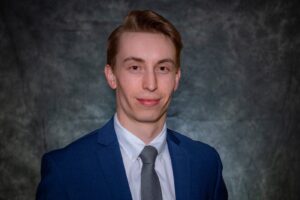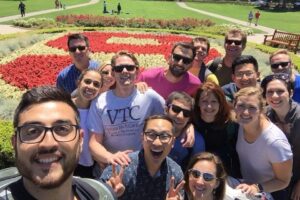The Virginia Tech Carilion School of Medicine has 240 alumni physicians working in hospitals and clinics across the country from its six graduating classes thus far, with another 45 from the class of 2020 soon joining them. They are in residencies and fellowships, and some are now attendings in private practice in every major specialty of medicine. The current COVID-19 pandemic has changed how each of them do their jobs, in big and small ways.
Nine of the alumni, currently located on the West Coast to the East Coast and in between, offered their perspective of how the pandemic is affecting them professionally and personally. Their stories are divided into a three-part story series. We start today with three from the West Coast. Part two will share stories from the Midwest and Northeast. Part three will focus on the Greater Washington, D.C., metro area and Roanoke, Virginia.
Brian Connor: Seattle, Washington

Brian Connor, VTCSOM Class of 2019, is an internal medicine resident at the University of Washington in Seattle, Washington. The first confirmed case in the United States was in Washington state. “Being one of the initial ‘hot-spots’ for the COVID-19 pandemic in the United States certainty came with its share of anxiety, personally, professionally and socially,” Connor said. “At the beginning of the outbreak in Seattle, we were not entirely sure how the virus spread: was it just respiratory droplets, could the virus live on surfaces? If so, for how long? Who was at greatest risk? How many people in the general population would be exposed? How long until the health care system would see its peak? What if I get sick?”
Connor said some of the residency learning experiences had to be canceled and staffing shifted to acute and intensive care units. “At first, it was disappointing. But it was inspiring how tirelessly and selflessly my co-residents volunteered to staff some of the most affected and time-consuming services, including the MICU. The sense of camaraderie and selflessness was pervasive and infectious. The desire to serve the community and support one another outmatched personal trepidation.”
Connor had to cancel a planned vacation back to Virginia to visit his family. Even with the sacrifices, he said the silver lining is that with everyone doing their part, he feels they are starting to see the difference.
“While the personal sacrifices we have all made during the past few months have been profound, I am optimistic that we, collectively, have started to make a difference,” Connor said. “People often reveal their truest nature in the face of adversity. I am hopeful that we will continue to rise to this historic occasion and emerge on the other side of this pandemic, stronger and less divided.”
Andrew Moore: Portland, Oregon

Less than 200 miles south, Andrew Moore, Class of 2014, is an attending emergency medicine physician finishing up his second year of a research fellowship at the Center for Policy and Research at Oregon Health and Science University. Oregon also saw some of the nation’s earliest confirmed cases in late February.
“One of the earlier cases was a teacher, and some of my colleagues had children that went to that school, so their children had to monitor symptoms for a couple of weeks,” Moore said. “So, when it hit here, it hit really close to home for a lot of the ER physicians.”
Moore said the community responded quickly with social distancing, and his health system prepared for the worst, with modified operations, cancelation of elective surgeries, and only essential personnel on site.
“Another major change we made is we took a lecture hall near the emergency department that is used for grand rounds and similar events and reverse engineered the ventilation system,” Moore said. “We turned the 200-seat auditorium into a negative pressure triage area for COVID patients that could hold upwards of a hundred patients.”
Thankfully, the space hasn’t been needed yet as cases have remained low in Oregon. Still, the preparation and steps to avoid a surge has been an adjustment. “Society and what we would consider every day, normal day life has fundamentally been altered with kids staying at home and all of the restaurants closed. But, the hospital still feels the same,” Moore said. “The amount of PPE that we wear every shift and our level of suspicion and attention to possible spread of respiratory illness has increased. But, other than that, it’s my area of normality in all of this.”
As Moore wraps up his final research fellowship year, he, along with his wife and toddler son, are preparing to move across the country back to Roanoke, Virginia. Moore will be an attending in the Department of Emergency Medicine at Carilion Clinic.
“Having seen multiple health care systems and interviewed at many different universities looking for my forever job, it really helped me to appreciate just the amazing things that that Carilion’s doing. When you combine that with the Virginia Tech Carilion School of Medicine, it’s just a fantastic opportunity to come back,” Moore said.
Jonathan Hootman: Santa Clara County, California

Continuing down the West Coast, Jonathan Hootman, Class of 2018, is an emergency medicine resident at Stanford University, where he works in three different emergency departments in Santa Clara County, California, which had its first confirmed case on Jan. 31.
Over the next month, Hootman said they saw an increased number of patients who were worried they may be infected and have COVID-19, but he was disturbed because some were worried just because they had been around a person of presumed Asian descent. “It was a frightening glimpse into nascent xenophobia and racism. However, many of these patients had no travel history or contact with sick individuals and/or tested positive for influenza, so our suspicion of COVID-19 infection was very low.”
By March, Stanford released a homegrown test for patients suspected of having COVID-19. “I’m not going to lie, I’m pretty proud of being part of an institution that released such an important test.”
By mid-March, the surrounding area was under shelter-in-place orders and the hospital system implemented strict protocols. Hootman has been serving on the front lines within the emergency department seeing numerous possible cases and treating both healthy and critically ill COVID-19 patients.
“I struggle with the physician-as-hero mythos being perpetuated on social media. I don’t feel like a hero, I just feel like I’m doing my job,” Hootman said. “Moreover, I certainly don’t feel like a hero compared to the residents and other health care workers in New York who are undoubtedly struggling with a substantially larger volume of patients and significantly more limited PPE resources. Ultimately, it leaves me with a bit of survivor’s guilt, and I hope the situation begins to slow and improve for my colleagues in New York.”
Hootman tries to adapt by hiking with his wife and dogs, binge watching favorite TV shows, including “Curb Your Enthusiasm,” and cultivating their indoor plant collection.

